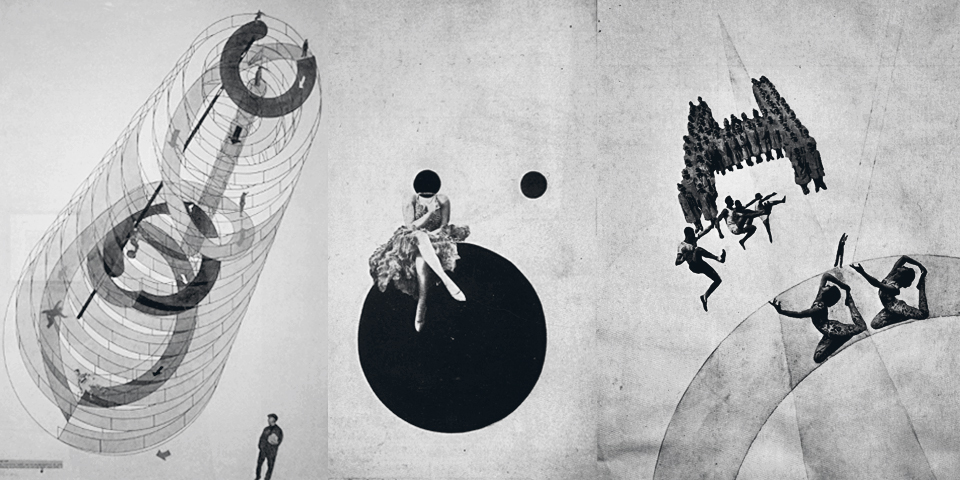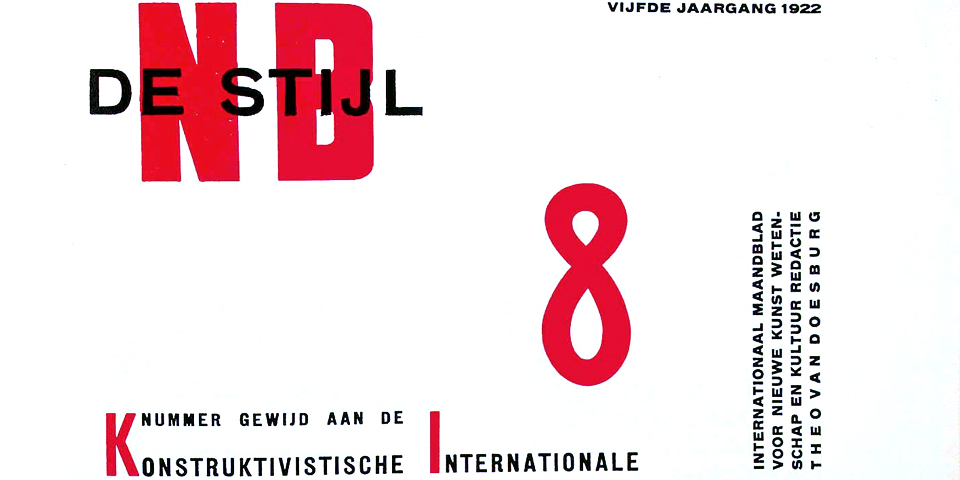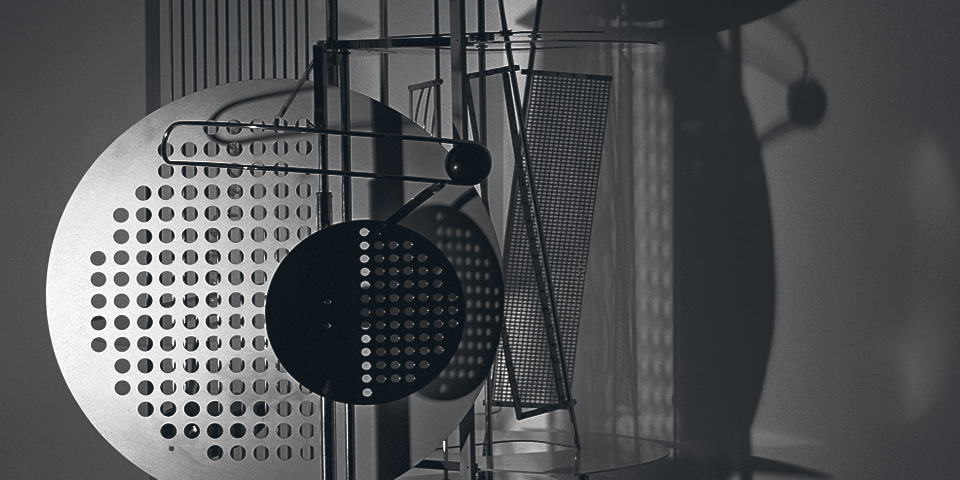IT’S ABOUT ART, MUSIC & LITERATURE
LÁSZLÓ MOHOLY–NAGY
SENSING THE FUTURE
László Moholy–Nagy is arguably one of the greatest influences on post–war art education in the United States. A modernist and a restless experimentalist from the outset, the Hungarian–born artist was shaped by Dadaism, Suprematism, Constructivism, and debates about photography. When Walter Gropius invited him to Bauhaus, in Dessau, Germany, he took over the school’s crucial preliminary course, and gave it a more practical, experimental, and technological bent. He later delved into various fields, from commercial design to theater set design, and also made films and worked as a magazine art director. But his greatest legacy was the version of Bauhaus teaching he brought to the United States, where he established the highly influential Institute of Design in Chicago.
A New Vision
“Every period has its own optical focus.”
Lightplay: Black–White–Gray
The Permanent Experiment
Bauhaus in Dessau
Moholy–Nagy was born in a small farming town in southern Hungary. His father abandoned the family when he was young, and his mother took Laszlo and his younger brother to live with their grandmother. “I lived my childhood years in a terrible great quietness”, he later wrote. He left for Budapest in 1913 to study law, but his studies were interrupted when he was drafted into the Army as an artillery officer in 1916. He experienced the horror of war on the Russian and Italian fronts, which remained with him for the rest of his life. He drew daily during this time as a soldier, sketching field life, his fellow officers, and the civilians he encountered. He discovered a passion for drawing, and though he finished his law degree after the war ended, he had already decided to become a painter.
He believed that humanity could only defeat the fracturing experience of modernity — only feel whole again — if it harnessed the potential of new technologies. Artists should transform into designers, and through specialization and experimentation find the means to answer humanity’s needs, His interest in photography encouraged his belief that artists’ understanding of vision had to specialize and modernize. Artists used to be dependent on the tools of perspective drawing, but with the advent of the camera they had to learn to see again. They had to renounce the classical training of previous centuries, which encouraged them to think about the history of art and to reproduce old formulas and experiment with vision, thus stretching human capacity to new tasks and his interest in qualities of space, time, and light endured throughout his career and transcended the very different media he employed. Whether he was painting or creating “photograms” [photographs made without the use of a camera or negative] or crafting sculptures made of transparent Plexiglass, he was ultimately interested in studying how all these basic elements interact.
“Designing is not a profession but an attitude. Design has many connotations. It is the organization of materials and processes in the most productive way, in a harmonious balance of all elements necessary for a certain function. It is the integration of technological, social, and economical requirements, biological necessities, and the psychological effects of materials, shape, color, volume and space. Thinking in relationships.”
Photogramm
Moholy–Nagy was fascinated by light throughout his career, and photograms offered the opportunity to experiment with the subtlety of light and shade. To create the photogram, he laid everyday objects on light–sensitive paper before exposing them to light. The brightness of the object’s silhouette depended on the exposure time — a longer exposure meant a brighter image. In this photogram a paintbrush lays over Moholy–Nagy’s hands, perhaps slyly suggesting the photogram is a medium of art that rivals painting.
Typophoto
Neither curiosity nor economic considerations alone but a deep human interest in what happens in the world have brought about the enormous expansion of the news–service: typography, the film and the radio. The creative work of the artist, the scientist’s experiments, the calculations of the business–man or the present–day politician, all that moves, all that shapes, is bound up in the collectivity of interacting events. The individual’s immediate action of the moment always has the effect of simultaneity in the long term. The technician has his machine at hand: satisfaction of the needs of the moment. But basically much more: he is the pioneer of the new social stratification, he paves the way for the future. The printer’s work, for example, to which we still pay too little attentionhas just such a long–term effect: international understanding and its consequences. The printer’s work is part of the foundation on which the new world will be built. Concentrated work of organization is the spiritual result which brings all elements of human creativity into a synthesis: the play instinct, sympathy, inventions, economic necessities. One man invents printing with movable type, another photography, a third screen–printing and stereotype, the next electrotype, phototype, the celluloid plate hardened by light. Men still kill one another, they have not yet understood how they live, why they live, politicians fail to observe that the earth is an entity, yet television [Telehor] has been invented: the ’Far Seer’ tomorrow we shall be able to look into the heart of our fellow–man, be everywhere and yet be alone, illustrated books, newspapers, magazines are printed — in millions. The unambiguousness of the real, the truth in the everyday situation is there for all classes. The hygiene of the optical, the health of the visible is slowly filtering through.
WHAT IS TYPOPHOTO ?
Typography is communication composed in type.
Photography is the art presentation of what can be optically apprehended.
Typophoto is the artly most exact rendering of communication.
Every period has its own optical focus. Our age: that of the film, the electric sign, simultaneity of sensorily perceptible events. It has given us a new, progressively developing creative basis for typography too. Gutenberg’s typography, which has endured almost to our own day, moves exclusively in the linear dimension. The intervention of the photographic process has extended it to a new dimensionality, recognised today as total. The preliminary work in this field was done by the illustrated papers, posters and by display printing. Until recently type face and type setting rigidly preserved a technique which admittedly guaranteed the purity of the linear effect but ignored the new dimensions of life. Only quite recently has there been typographic work which uses the contrasts of typographic material [letters, signs, positive and negative values of the plane] in an attempt to establish a correspondence with modern life. These efforts have, however, done little to relax the inflexi— bility that has hitherto existed in typographic practice An effective loosening–up can be achieved only by the most sweeping and all–embracing use of the techniques of photography, zincography the electrotype, etc. The flexibility and elasticity of these techniques bring with them a new reciprocity between economy and beauty With the development of photo–telegraphy, which enables reproductions and accurate illustrations to be made instantaneously even philosophical at works will presumably use the same means though on a higher plane as the present clay American magazines. The form of these new typographic works will, of course, be quite different typographically, optically, and synopticaliy from the linear typography of today. Linear typography communicating ideas is merely a mediating makeshift link between the content of the communication and the person receiving it:
COMMUNICATION TYPOGRAPHY PERSON
Instead of using typography–as hitherto–merely as an objective means, the attempt is now being made to incorporate it and the potential effects of its subjective existence creatively into the contents. The typographical materials themselves contain strongly optical tangibilities by means of which they can render the content of the communication in a directly visible — not only in an indirectly intellectual — fashion. Photography is highly effective when used as typographical material. It may appear as illustration beside the words, or in the form of ’phototext’ in place of words, as a precise form of representation so objective as to permit of no individual interpretation. The form, the rendering is constructed out of the optical and associative relationships: into a art, associative,conceptual, synthetic continuity: into the typo–photo as an unambiguous rendering in an optically valid form.
The typophoto governs the new tempo of the new art literature.
In the future every printing press will possess its own block–making plant and it can be confidently stated that the future of typographic methods lies with the photo–mechanical processes. The invention of the photographic typesetting machine, the possibility of printing whole editions with X–ray radiography, the new cheap techniques of block making, etc., indicate the trend to which everytypographer or typophotographer must adapt himself as soon as possible.
This mode of modern synoptic communication may be broadly pursued on another plane by means of the kinetic process, the film.
Moholy–Nagy’s influence on American art was felt broadly in several disciplines. Along with the other emigres from the Bauhaus, he succeeded in instilling a modern aesthetic into American design. His impact was felt most strongly by his students, but his use of modern materials and technology impressed other young designers, including Charles Eames, who visited the New Bauhaus while studying at the Cranbrook Academy of Art. Moholy–Nagy’s influence on photography is felt equally through his writings as through his photographs and photomontages. His first Bauhaus book established photography as a fine art equal to painting. His experiments in light and shadow reinforced photography’s value as a subjective medium, and therefore an artistic medium, rather than simply a means to document reality.
Recent years have brought international attention to Moholy–Nagy’s achievements with several major museums organizing retrospectives, including the Tate Modern in London, the Schirn Kunsthalle in Frankfurt, and the Loyola University Museum of Art in Chicago, that celebrate the impact of his work on American art.
















